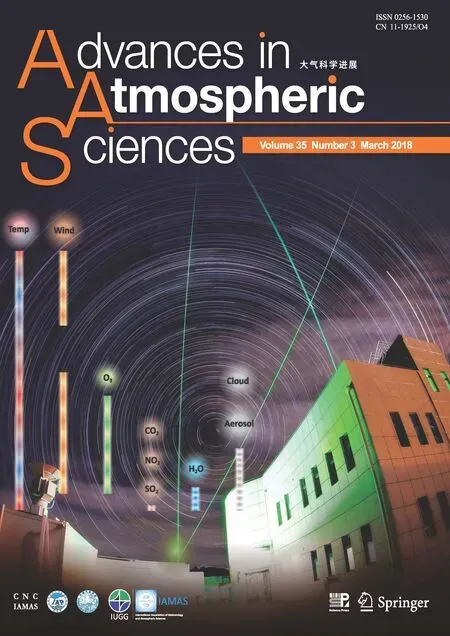2017 was the Warmest Year on Record for the Global Ocean
Lijing CHENGand Jiang ZHU
International Center for Climate and Environment Sciences,Institute of Atmospheric Physics,Chinese Academy of Sciences,Beijing,100029,China
2017 was the warmest year on record for the global ocean according to an updated Institute of Atmospheric Physics,Chinese Academy of Sciences(IAP,CAS;http://english.iap.cas.cn/)ocean analysis.The oceans in the upper 2000 m were 1.51×1022J warmer than the second warmest year of 2015 and 19.19×1022J above the 1981–2010 climatological reference period(Fig.1).For comparison,total electricity generation in China in 2016 was 0.00216×1022J,which is 699 times smaller than the increase in ocean heat in 2017.
The long-term warming trend driven by human activities continued unabated.The high ocean temperatures in recent years have occurred as greenhouse gas levels in the atmosphere have also risen,reaching record highs in 2017.The results support the provisional announcement by the World Meteorological Organization in November 2017 that“Global ocean heat content in 2017 to date has been at or near record high levels”.
Owing to its large heat capacity,the ocean accumulates the warming derived from human activities;indeed,more than 90%of Earth’s residual heat related to global warming is absorbed by the ocean.As such,the global ocean heat content record robustly represents the signature of global warming and is impacted less by weather-related noise and climate variability such as El Ni?no and La Ni?na events.The year 2016 was cooler than both 2015 and 2017 owing to the huge El Ni?no,which took some of the heat out of the ocean.According to the IAP ocean analysis,the lastfive years have been thefive warmest years in the ocean.Measurements of ocean heating are a more reliable indicator than atmospheric measurements for tracking the vital signs of the health of the planet.Table 1 shows the ranking of thefive warmest years.
The increase in ocean heat content for 2017 occurred in most regions of the world(Fig.2).The Atlantic and Southern oceans(south of 30?S)showed more warming than the Pacific and Indian oceans.The Atlantic Ocean(north of 30?S)and Southern Ocean were 4.87×1022and 7.36×1022J above the 1981–2010 period,respectively.Increases in ocean temperature cause ocean volume expansion,which contributes to the global mean sea level rise.The increase in ocean heat of 1.51×1022J in 2017 resulted in a 1.7 mm sea global level rise.Other consequences include declining ocean oxygen,bleaching of coral reefs,and melting sea ice and ice shelves.The human greenhouse gas footprint continues to impact the Earth system.

Fig.1.Change in global upper-level(0–2000 m)ocean heat content since 1958.Each bar shows the annual mean relative to a 1981–2010 baseline.Thefinal bar on the right shows the 2017 value.Reliable ocean temperature records date back to 1958.Source:IAP ocean analysis.

Fig.2.Annual mean ocean heat content anomaly in 2017 relative to a 1981–2010 baseline.Units:109J m?2.Source:IAP ocean analysis.

Table 1.Topfive warmest years in the ocean since 1958.The ocean heat content values are the anomalies(units:J)relative to the 1981–2010 average.
Data and method
The IAP provides an observation-based ocean temperature analysis from the sea surface down to a depth of 2000 m,available from the year 1940(http://159.226.119.60/cheng/).All the available in-situ ocean observations from the National Oceanic and Atmospheric Administration/National Centers for Environmental Information(NOAA/NCEI)(Boyer et al.,2013)are used in the analysis.For the current century,the Argo network provides observations with near-global ocean coverage,significantly improving the availability of ocean observations(Argo,2000).
The importance of ocean heat content in climate monitoring is thoroughly discussed in Cheng et al.(2018).A gridded ocean temperature dataset with complete global ocean coverage is a highly valuable resource for understanding climate change and variability.The IAP provides an objective analysis of historical ocean subsurface temperature through several innovative steps.First,an updated set of past observations,newly corrected for biases[e.g.,in Expendable Bathythermograph-XBTs],is used.The XBT bias was corrected by the CH14 scheme(Cheng et al.,2014),which is recommended by the XBT community.Second,the covariability between values at different places in the ocean and background information from several climate models that include a comprehensive ocean model is used.Third,the influence of each observation has been extended over a larger area,recognizing the relative homogeneity of the vast open expanses of the southern oceans.Subsequently,the observations can also be used to providefiner-scale detail.Andfinally,the new analysis has been carefully evaluated using knowledge of recent well-observed ocean states,but subsampled using the sparse distribution of observations in the more distant past to show that the method produces unbiased historical reconstruction.The method works well back to the late 1950s,but prior to then there are too few observations to make reliable ocean state estimates.The methodology is summarized in Cheng et al.(2017).
Acknowledgements.The authors acknowledge NOAA/NCEI for providing the in-situ observations,which are the basis for our analysis.The IAP analysis is supported by the National Key Research and Development Program of China(Grant Nos.2017YFA0603202and2016YFC1401705).TheArgodatawerecollected and made freely available by the International Argo Program and the national programs that contribute to it(http://www.argo.ucsd.edu;http://argo.jcommops.org).The Argo Program is part of the Global Ocean Observing System.
Argo,2000:Argofloat data and metadata from global data assembly Centre(Argo GDAC).SEANOE.http://doi.org/10.17882/42182.
Boyer,T.P.,and Coauthors,2013:World ocean database 2013.Sydney Levitus,Alexey Mishonov.S.Levitus,Eds.,NOAA,209 pp.
Cheng L.J.,J.Zhu,R.Cowley,T.Boyer,and S.Wijffels,2014:Time,probe type,and temperature variable bias corrections to historical expendable bathythermograph observations.J.Atmos.Oceanic Technol.,31(8),1793–1825.http://doi.org/10.1175/JTECH-D-13-00197.1.
Cheng L.J.,K.E.Trenberth,J.Fasullo,T.Boyer,J.Abraham,and J.Zhu,2017:Improved estimates of ocean heat content from 1960 to 2015.Science Advances,3,e1601545.http://dx.doi.org/10.1126/sciadv.1601545.
Cheng L.J.,K.E.Trenberth,J.Fasullo,J.Abraham,T.P.Boyer,K.von Schuckmann,and J.Zhu,2018:Taking the pulse of the planet.Eos,99,14-16.http://dx.doi.org/10.1029/2017EO081839.
 Advances in Atmospheric Sciences2018年3期
Advances in Atmospheric Sciences2018年3期
- Advances in Atmospheric Sciences的其它文章
- Anomalous Western Pacific Subtropical High during El Ni?no Developing Summer in Comparison with Decaying Summer
- Three-dimensional Fusion of Spaceborne and Ground Radar Reflectivity Data Using a Neural Network–Based Approach
- Data Assimilation Method Based on the Constraints of Confidence Region
- Asymmetric Variations in the Tropical Ascending Branches of Hadley Circulations and the Associated Mechanisms and Effects
- Statistics-based Optimization of the Polarimetric Radar Hydrometeor Classification Algorithm and Its Application for a Squall Line in South China
- New Method for Estimating Daily Global Solar Radiation over Sloped Topography in China
